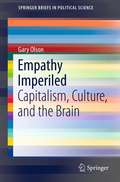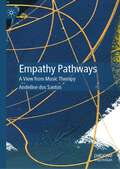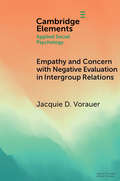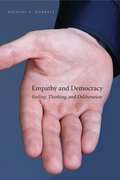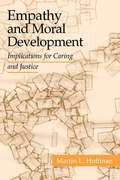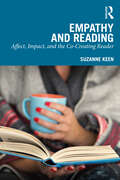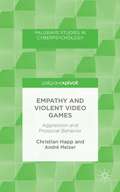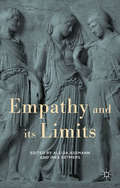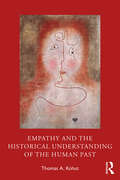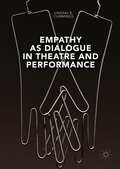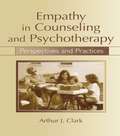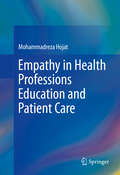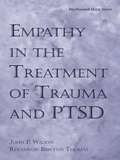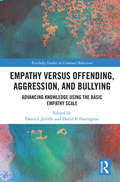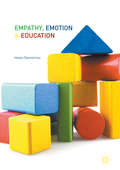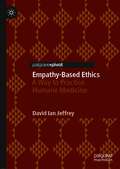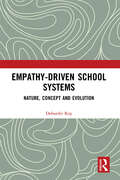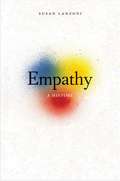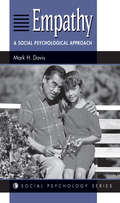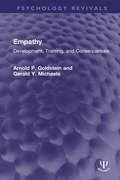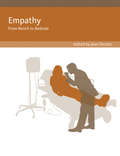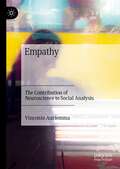- Table View
- List View
Empathy Imperiled
by Gary OlsonThe most critical factor explaining the disjuncture between empathy's revolutionary potential and today's empathically-impaired society is the interaction between the brain and our dominant political culture. The evolutionary process has given rise to a hard-wired neural system in the primal brain and particularly in the human brain. This book argues that the crucial missing piece in this conversation is the failure to identify and explain the dynamic relationship between an empathy gap and the hegemonic influence of neoliberal capitalism, through the analysis of the college classroom, the neoliberal state, media, film and photo images, marketing of products, militarization, mass culture and government policy. This book will contribute to an empirically grounded dissent from capitalism's narrative about human nature. Empathy is putting oneself in another's emotional and cognitive shoes and then acting in a deliberate, appropriate manner. Perhaps counter-intuitively, it requires self-empathy because we're all products of an empathy-anesthetizing culture. The approach in this book affirms a scientific basis for acting with empathy, and it addresses how this can help inform us to our current political culture and process, and make its of interest to students and scholars in political science, psychology, and other social sciences.
Empathy Pathways: A View from Music Therapy
by Andeline dos SantosMany descriptions of empathy revolve around sharing in and understanding another person’s emotions. One separate person gains access to the emotional world of another. An entire worldview holds up this idea. It is individualistic and affirms the possibility of access to other people’s “inner world.” Can we really see inside another, though? And are we discrete, separate selves? How can we best grapple with these questions in the field of music therapy? In response, this book offers four empathy pathways. Two are situated in a constituent approach (that prioritises discrete individuals who then enter into relationships with one another) and two are located in relational approaches (that acknowledge the foundational reality of relationships themselves). By understanding empathy more fully, music therapists, teachers and researchers can engage in ways that are congruent with diverse worldviews and ways of being. Examples used in the book are from active and receptive music therapy approaches as well as from community and clinical contexts, so as to provide clear links to practice. This book will be a valuable resource for academics and postgraduate students within music therapy and allied fields including art therapy, drama therapy, dance/movement therapy, psychology, counselling, occupational therapy and social development studies.
Empathy and Concern with Negative Evaluation in Intergroup Relations: Implications for Designing Effective Interventions (Elements in Applied Social Psychology)
by Jacquie D. VorauerThe widespread belief in the benefits of empathy and its healing power is evident in public discourse and across diverse news and social media outlets around the world. Yet research reveals that empathy can sometimes have adverse effects on individuals' intergroup attitudes and behavior. A link between empathy and concerns with negative evaluation helps explain why empathy can backfire. Accordingly, using the minimization of evaluative concerns as an organizing principle, the author makes recommendations regarding when and how to encourage empathy in intergroup contexts, so that its potential to foster stronger social bonds across group boundaries can be fully realized.
Empathy and Democracy: Feeling, Thinking, and Deliberation
by Michael E. MorrellDemocracy harbors within it fundamental tensions between the ideal of giving everyone equal consideration and the reality of having to make legitimate, binding collective decisions. Democracies have granted political rights to more groups of people, but formal rights have not always guaranteed equal consideration or democratic legitimacy. It is Michael Morrell’s argument in this book that empathy plays a crucial role in enabling democratic deliberation to function the way it should. Drawing on empirical studies of empathy, including his own, Morrell offers a “process model of empathy” that incorporates both affect and cognition. He shows how this model can help democratic theorists who emphasize the importance of deliberation answer their critics.
Empathy and Mental Health: An Integral Model for Developing Therapeutic Skills in Counseling and Psychotherapy
by Arthur J. ClarkEmpathy and Mental Health shows mental health professionals how to employ a deeper understanding of subjective, objective, and interpersonal modalities of empathy in their practice. Chapters are full of case studies and examples that demonstrate empathy’s role in challenging and complex encounters, and as each concept and process is introduced, Dr. Clark discusses strategies for responding empathically. The book has a sound theoretical grounding that is informed by extensive material on empathy and empathic understanding from the counseling and psychotherapy literature and related fields of inquiry. Drawing from psychodynamic, existential-humanistic, cognitive behavioral, and other contemporary orientations, this text makes empathy immediately useful and understandable to students and practitioners.
Empathy and Moral Development: Implications for Caring and Justice
by Martin L. HoffmanThis volume provides the first comprehensive account of prosocial moral development in children. The book's focus is empathy's contribution to altruism and compassion for others in physical, psychological, or economic distress; feelings of guilt over harming someone; feelings of anger at others who do harm; feelings of injustice when others do not receive their due.
Empathy and Reading: Affect, Impact, and the Co-Creating Reader
by Suzanne KeenThis pioneering collection brings together Suzanne Keen’s extensive body of work on empathy and reading, charting the development of narrative empathy as an area of inquiry in its own right and extending cross-disciplinary conversations about empathy evoked by reading. The volume offers a brief overview of the trajectory of research following the 2007 publication of Empathy and the Novel, with empathy understood as a suite of related phenomena as stimulated by representations in narratives. The book is organized around three thematic sections—theories; empathetic readers; and interdisciplinary applications—each preceded by a short framing essay. The volume features excerpts from the author’s seminal works on narrative empathy and makes available her harder-to-access contributions. The book brings different strands of the author’s research into conversation with existing debates, with the aim of inspiring future interdisciplinary research on narrative empathy. This book will be of interest to students and scholars in such fields as literary studies, cognitive science, emotion studies, affect studies, and applied contexts where empathetic practitioners work.
Empathy and Reading: Affect, Impact, and the Co-Creating Reader
by Suzanne KeenThis pioneering collection brings together Suzanne Keen’s extensive body of work on empathy and reading, charting the development of narrative empathy as an area of inquiry in its own right and extending cross-disciplinary conversations about empathy evoked by reading. The volume offers a brief overview of the trajectory of research following the 2007 publication of Empathy and the Novel, with empathy understood as a suite of related phenomena as stimulated by representations in narratives. The book is organized around three thematic sections—theories; empathetic readers; and interdisciplinary applications—each preceded by a short framing essay. The volume features excerpts from the author’s seminal works on narrative empathy and makes available her harder-to-access contributions. The book brings different strands of the author’s research into conversation with existing debates, with the aim of inspiring future interdisciplinary research on narrative empathy. This book will be of interest to students and scholars in such fields as literary studies, cognitive science, emotion studies, affect studies, and applied contexts where empathetic practitioners work.
Empathy and Violent Video Games: Aggression and Prosocial Behavior
by Christian Happ André MelzerThrough three empirical studies, this book explores the mechanisms behind moderating functions of empathy in violent video games, revealing new insights that will inform the ongoing debates about the effects violent media content.
Empathy and its Limits
by Aleida Assmann Ines DetmersThis volume extends the theoretical scope of the important concept of empathy by analysing not only the cultural contexts that foster the generating of empathy, but in focusing also on the limits of pro-social feelings and the mechanisms that lead to its blocking.
Empathy and the Historical Understanding of the Human Past
by Thomas A. KohutEmpathy and the Historical Understanding of the Human Past is a comprehensive consideration of the role of empathy in historical knowledge, informed by the literature on empathy in fields including history, psychoanalysis, psychology, neuroscience, philosophy, and sociology. The book seeks to raise the consciousness of historians about empathy, by introducing them to the history of the concept and to its status in fields outside of history. It also seeks to raise the self-consciousness of historians about their use of empathy to know and understand past people. Defining empathy as thinking and feeling, as imagining, one’s way inside the experience of others in order to know and understand them, Thomas A. Kohut distinguishes between the external and the empathic observational position, the position of the historical subject. He argues that historians need to be aware of their observational position, of when they are empathizing and when they are not. Indeed, Kohut advocates for the deliberate, self-reflective use of empathy as a legitimate and important mode of historical inquiry. Insightful, cogent, and interdisciplinary, the book will be essential for historians, students of history, and psychoanalysts, as well as those in other fields who seek to seek to know and understand human beings.
Empathy as Dialogue in Theatre and Performance
by Lindsay B. B. CummingsEmpathy has provoked equal measures of excitement and controversy in recent years. For some, empathy is crucial to understanding others, helping us bridge social and cultural differences. For others, empathy is nothing but a misguided assumption of access to the minds of others. In this book, Cummings argues that empathy comes in many forms, some helpful to understanding others and some detrimental. Tracing empathy's genealogy through aesthetic theory, philosophy, psychology, and performance theory, Cummings illustrates how theatre artists and scholars have often overlooked the dynamic potential of empathy by focusing on its more "monologic" forms, in which spectators either project their point of view onto characters or passively identify with them. This book therefore explores how empathy is most effective when it functions as a dialogue, along with how theatre and performance can utilise the live, emergent exchange between bodies in space to encourage more dynamic, dialogic encounters between performers and audience.
Empathy in Counseling and Psychotherapy: Perspectives and Practices
by Arthur J. ClarkThe purpose of this text is to organize the voluminous material on empathy in a coherent and practical manner, filling a gap that exists in the current therapeutic literature. Empathy in Counseling and Psychotherapy: Perspectives and Practices comprehensively examines the function of empathy as it introduces students and practitioners to the potential effectiveness of utilizing empathic understanding in the treatment process. Employing empathy with full recognition of its strengths and limitations promotes sound strategies for enhancing client development. As an integral component of the therapeutic relationship, empathic understanding is indispensable for engaging clients from diverse backgrounds. This cogent work focuses on understanding empathy from a wide range of theoretical perspectives and developing interventions for effectively employing the construct across the course of treatment. The book also presents a new approach for integrating empathy through a Multiple Perspective Model in the therapeutic endeavor. Organized into three sections, the text addresses empathy in the following capacities:*historical and contemporary perspectives and practices in counseling and psychotherapy;*theoretical orientations in counseling and psychotherapy; and*a Multiple Perspective Model in counseling and psychotherapy. This widely appealing volume is designed for use in courses in counseling and therapy techniques, theories of counseling and psychotherapy, and the counseling internship, and is a valuable resource for counselors, psychotherapists, psychologists, psychiatrists, social workers, and other related fields of inquiry in the human services.
Empathy in Health Professions Education and Patient Care
by Mohammadreza HojatThis welcome updated and expanded edition offers new findings and insights into this cornerstone of practice as well as effective tools for its clinical use. Spanning psychodynamic theory to neuroscience and evolution to medicine, the book defines empathy in the context of patient care, and both in its critical role as a human attribute and in its necessity in promoting change and healing. Theory and data link practitioner empathy with patients' positive outcomes in areas such as provider trust, treatment adherence, clinical improvements, and quality of life. Author also provide convincing evidence in support of validity and reliability of the Jefferson Scale of Empathy for measuring the empathy of practitioners and students in the healing professions, and detail obstacles to developing and strategies for enhancing empathy among care providers. Among the topics covered: * Definition of empathy in patient care. * Conceptualization and consequences of empathy and sympathy in patient care. * An evolutionary perspective, sociophysiology, and heritability of empathy. * Measurement of empathy in the general population and in health professions-in-training, and in-practice. * Interpersonal dynamics in clinician-patient relationships. * Ten approaches to enhance empathy in Health professions education and patient care. * Exploration of neurological underpinnings of empathy. * Plus in-depth discussion of development, psychometrics, and correlates of the Jefferson Scale of Empathy. An essential text in theory and applications, Empathy in Health Professions Education and Patient Care enhances the work of health professions students, faculty, and practitioners in a variety of disciplines such as medicine, nursing, dentistry, psychology, clinical social work, and other health professions.
Empathy in the Treatment of Trauma and PTSD (Psychosocial Stress Series)
by John P. Wilson, Ph.D. Rhiannon Brywnn Thomas, Ph.D.Empathy in the Treatment of Trauma and PTSD examines how professionals are psychologically impacted by their work with trauma clients. A national research study provides empirical evidence, documenting the struggle for professionals to maintain therapeutic equilibrium and empathic attunement with their trauma clients. Among the many important findings of this study, all participants reported being emotionally and psychologically affected by the work, often quite profoundly leading to changes in worldview, beliefs about the nature of humankind and the meaning of life.John P. Wilson and Rhiannon Thomas set out to understand how to heal those who experience empathic strain in the course of their professional specialization. The data included in the book allows for the development of conceptual dynamic models of effective management of empathic strain, which may cause vicarious traumatization, burnout and serious countertransference processes.
Empathy versus Offending, Aggression and Bullying: Advancing Knowledge using the Basic Empathy Scale (Routledge Studies in Criminal Behaviour)
by David P. Farrington Darrick JolliffeThis book advances knowledge about the measurement of empathy, using the Basic Empathy Scale (BES), and how empathy is related to offending, aggression, and bullying in community and incarcerated groups. Empathy is widely accepted as one of the most important individual factors that is related to offending, aggression, and bullying, and it is common in many intervention projects to aim to improve empathy in order to reduce offending, aggression, and bullying. The BES was constructed by Jolliffe and Farrington (2006) and has been widely used in a number of countries. This book presents a collection of papers exploring the application of BES in 10 different countries (England, Portugal, Spain, Poland, Italy, the Netherlands, Croatia, Australia, Canada, and the USA). Each chapter reviews the use of the BES in that particular jurisdiction, its psychometric properties, and its importance in relation to offending, aggression, and bullying. The research includes samples from primary schools, secondary schools, and the community, as well as those who are justice-involved and on probation, in prisons and secure psychiatric hospitals. In bringing together this broad range of contributions, the book concludes with wider implications for intervention, policy, and practice. This book will be valuable for students, academics, and practitioners who are interested in developing their understanding of the complex link between empathy and a range of antisocial behaviours.
Empathy, Emotion and Education
by Helen DemetriouThis book explores the construct of empathy and its connection with education. Charting literature on the origins and evolution of the concept of empathy, the author examines the multifaceted nature of empathy and the external and internal influences behind this concept. The relationship between empathy and education is examined through the impact they have on each other for the development of social and emotional understanding, positive social behaviours and effective teaching and learning. In doing so, the author emphasises that empathy apparent in the early years of life is invaluable for enhancing the quality of teaching and learning in future, and should be elicited from pupils and teachers alike. This book will be of interest to practitioners, educational psychologists, and researchers in empathy and its effect on education.
Empathy, Normalization and De-escalation: Management of the Agitated Patient in Emergency and Critical Situations
by Massimo Biondi Massimo Pasquini Lorenzo TarsitaniThis book describes theory and techniques of empathic communication, normalization and de-escalation procedures for the management of aggressive or violent patients in clinical critical settings'. Consisting of 9 chapters, it discusses in detail the self-regulation of empathy in potential dangerous interactions, as well as common mistakes and nonprofessional reactions. It also explores the basic concept of neurobiology of violence and aggression behaviour, such as brain circuitry and neuromodulators, and other rapid tranquillization guidelines. The final chapter focuses on the crucial topics of post-aggression debriefing.Based on the clinical experience of the editors and authors, who work in emergency psychiatry settings, the book offers practical key expressions to promote a normalization talk, to calm agitated individuals, and to prevent crises both for psychiatric patients and people without mental disorders.It is a useful tool to help readers gain confidence as mediators in critical circumstances and will be of interest for a wide range of practitioners in healthcare settings, from psychiatrists and psychologists, to nurses and other healthcare workers.
Empathy-Based Ethics: A Way to Practice Humane Medicine
by David Ian JeffreyThis book explores a new way of applying clinical ethics. Empathy-based ethics is based on the patient–doctor relationship and seeks to encourage a more humane form of medical practice. The author argues that the current emphasis on the biomedical model of medicine and a detached concern form of professionalism have damaged the patient–doctor relationship. He investigates examples of the dehumanization of patients and demonstrates a contrasting view of humane care. The book presents empathy as a relational construct - it provides an in-depth analysis of the process of empathizing. It discusses an empathy-based ethics approach underpinned by clinical examples of the practical application of this new approach. It suggests how empathy-based ethics can be embedded in clinical practice, medical education and research. The book concludes by examining the challenges in implementing such an approach and looks to a future which redresses the current imbalance between biomedical and psychosocial approaches to medicine.
Empathy-Driven School Systems: Nature, Concept and Evolution
by Debarshi RoyThis book provides a framework for designing behavioural systems in schools that recognize empathy as its core driver. It presents a systemic discourse on introducing steps in schools to promote inclusivity and acceptance. The book analyses how empathy can be integrated into every aspect of school education. It focuses on the role of schools in nurturing compassion in young children and providing a positive psychological atmosphere for them. The author outlines the concept of empathy and its application to organizations in general and its specific application within school systems. Drawing from theoretical and empirical literature, the book examines the designs for holistic empathy-driven learning, highlighting its role in fostering social integration and developing social and emotional skills in students of diverse backgrounds. This book will be of interest to students, teachers and researchers of education, organizational psychology, organizational behaviour and child psychology. It will also be useful for educationalists, schoolteachers, school management professionals, heads of schools and parents.
Empathy: A History
by Susan LanzoniA surprising, sweeping, and deeply researched history of empathy—from late-nineteenth-century German aesthetics to mirror neurons†‹Empathy: A History tells the fascinating and largely unknown story of the first appearance of “empathy” in 1908 and tracks its shifting meanings over the following century. Despite empathy’s ubiquity today, few realize that it began as a translation of Einfühlung or “in-feeling” in German psychological aesthetics that described how spectators projected their own feelings and movements into objects of art and nature. Remarkably, this early conception of empathy transformed into its opposite over the ensuing decades. Social scientists and clinical psychologists refashioned empathy to require the deliberate putting aside of one’s feelings to more accurately understand another’s. By the end of World War II, interpersonal empathy entered the mainstream, appearing in advice columns, popular radio and TV, and later in public forums on civil rights. Even as neuroscientists continue to map the brain correlates of empathy, its many dimensions still elude strict scientific description. This meticulously researched book uncovers empathy’s historical layers, offering a rich portrait of the tension between the reach of one’s own imagination and the realities of others’ experiences.
Empathy: A Social Psychological Approach
by Mark H DavisEmpathy has long been a topic of interest to psychologists, but it has been studied in a sometimes bewildering number of ways. In this volume, Mark Davis offers a thorough, evenhanded review of contemporary empathy research, especially work that has been carried out by social and personality psychologists.Davis' approach is explicitly multidimensional. He draws careful distinctions between situational and dispositional “antecedents” of empathy, cognitive and noncognitive “internal processes,” affective and nonaffective “intrapersonal outcomes,” and the “interpersonal behavioral outcomes” that follow. Davis presents a novel organizational model to help classify and interpret previous findings. This book will be of value in advanced undergraduate and graduate courses on altruism, helping, and moral development.
Empathy: Development, Training, and Consequences (Psychology Revivals)
by Arnold P. Goldstein Gerald Y. MichaelsOriginally published in 1985, this book sought to thoroughly examine and better understand a dimension of interpersonal relations which at the time had often proven elusive, confusing, and quite difficult to operationalize. Empathy had been diversely defined, hard to measure, often resistant to change, yet emerged as a singularly important influence in human interaction. The Editors lengthy effort to better understand its nature, consequences and alteration was not an easy journey, yet was a rewarding one. This book presents the fruits of their journey, and thus they hoped the reader would feel equally rewarded. The several diverse definitions of empathy are sequentially presented and examined in Chapter 1, in an effort to begin this book with a shared understanding of the major historical and contemporary meanings of the construct. The Editors conclude this initial chapter by subscribing themselves to a particular components definition of empathy, a definition they predict will prove particularly useful in enhancing future understanding, investigation, and application of empathic behaviour. This components definition, therefore, substantially influences and shapes much of the content of the rest of the book.
Empathy: From Bench to Bedside (Social Neuroscience)
by Jean DecetyRecent work on empathy theory, research, and applications, by scholars from disciplines ranging from neuroscience to psychoanalysis.There are many reasons for scholars to investigate empathy. Empathy plays a crucial role in human social interaction at all stages of life; it is thought to help motivate positive social behavior, inhibit aggression, and provide the affective and motivational bases for moral development; it is a necessary component of psychotherapy and patient-physician interactions. This volume covers a wide range of topics in empathy theory, research, and applications, helping to integrate perspectives as varied as anthropology and neuroscience. The contributors discuss the evolution of empathy within the mammalian brain and the development of empathy in infants and children; the relationships among empathy, social behavior, compassion, and altruism; the neural underpinnings of empathy; cognitive versus emotional empathy in clinical practice; and the cost of empathy.Taken together, the contributions significantly broaden the interdisciplinary scope of empathy studies, reporting on current knowledge of the evolutionary, social, developmental, cognitive, and neurobiological aspects of empathy and linking this capacity to human communication, including in clinical practice and medical education.
Empathy: The Contribution of Neuroscience to Social Analysis
by Vincenzo AuriemmaThis book examines the concept of empathy in sociological and neuroscientific discourses using innovative perspectives from sociology and social neuroscience. Through a transdisciplinary approach, the author delves into the history of empathy and its social, cultural and semantic changes, and then reviews the conception of empathy in neuroscientific discourse.Distancing itself from the traditional neuroscientific literature of biological universalism, this volume offers an innovative perspective on empathy. It also opens a new avenue for neurosociology, which is presented as the discipline that can emphasize all the cultural and emotional aspects that govern empathy. Key themes addressed in the text are: empathy in all its meanings, from Hume to TenHouten; neurosociology as one possible avenue for embracing the cultural and neuroscientific aspects of empathy; and empirical research. A valuable resource for sociology students and academics in the field of empathy and neurosociology, this book is also of interest to those studying sociological thought, and social neuroscience.
